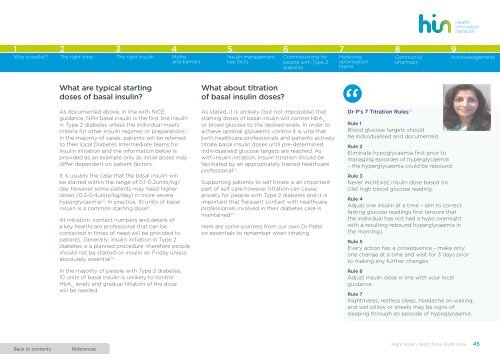1gOgRTa
1gOgRTa
1gOgRTa
Create successful ePaper yourself
Turn your PDF publications into a flip-book with our unique Google optimized e-Paper software.
1 2 3 4 5 6 7 8Why a toolkit?The right time The right insulin Mythsand barriersInsulin management:key factsCommissioning forpeople with Type 2diabetesMedicinesoptimisationteamsCommunitypharmacy9AcknowledgementsWhat are typical startingdoses of basal insulin?As documented above, in line with NICEguidance, NPH basal insulin is the first line insulinin Type 2 diabetes unless the individual meetscriteria for other insulin regimes or preparations 21 .In the majority of cases, patients will be referredto their local Diabetes Intermediate teams forInsulin initiation and the information below isprovided as an example only as initial doses maydiffer dependent on patient factors.It is usually the case that the basal insulin willbe started within the range of 0.1-0.2units/kg/day however some patients may need higherdoses (0.3-0.4units/kg/day) in more severehyperglycaemia 20 . In practice, 10 units of basalinsulin is a common starting dose 81 .At initiation, contact numbers and details ofa key healthcare professional that can becontacted in times of need will be provided topatients. Generally, insulin initiation in Type 2diabetes is a planned procedure; therefore peopleshould not be started on insulin on Friday unlessabsolutely essential 55 .In the majority of people with Type 2 diabetes,10 units of basal insulin is unlikely to controlHbA 1clevels and gradual titration of the dosewill be needed.What about titrationof basal insulin doses?As stated, it is unlikely (but not impossible) thatstarting doses of basal insulin will control HbA 1cor blood glucose to the desired levels. In order toachieve optimal glycaemic control it is vital thatboth healthcare professionals and patients activelytitrate basal insulin doses until pre-determinedindividualised glucose targets are reached. Aswith insulin initiation, insulin titration should befacilitated by an appropriately trained healthcareprofessional 54 .Supporting patients to self titrate is an importantpart of self care however titration can causeanxiety for people with Type 2 diabetes and it isimportant that frequent contact with healthcareprofessionals involved in their diabetes care ismaintained 20 .Here are some pointers from our own Dr Patelon essentials to remember when titrating.“Dr P’s 7 Titration Rules 82Rule 1Blood glucose targets shouldbe individualised and documented.Rule 2Eliminate hypoglycaemia first prior tomanaging episodes of hyperglycaemia– the hyperglycaemia could be rebound.Rule 3Never INCREASE insulin dose based onONE high blood glucose reading.Rule 4Adjust one insulin at a time – aim to correctfasting glucose readings first (ensure thatthe individual has not had a hypo overnightwith a resulting rebound hyperglycaemia inthe morning).Rule 5Every action has a consequence – make onlyone change at a time and wait for 3 days priorto making any further changes.Rule 6Adjust insulin dose in line with your localguidance.Rule 7Nightmares, restless sleep, headache on waking,and wet pillow or sheets may be signs ofsleeping through an episode of hypoglycaemia.Back to contentsReferencesRight Insulin, Right Time, Right Dose 45


